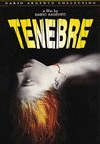Tenebre
Anchor Bay Entertainment
Cast: Anthony Franciosa, John Saxon, Daria Nicolodi
Extras: Theatrical Trailer, Commentary Track, Behind-The-Scenes Segments
Rating:
For the past 17 years, Italian director Dario Argento’s "Tenebre" was only available in the United States in an edited form. But now, thanks to Anchor Bay Entertainment and the Roan Group, "Tenebre" can be viewed the way Argento meant for audiences to see it. This is the first time that the film has been (legally) available in its uncut form in the US. Not only is this a blessing for fans of the film and admirers of the director, but also an opportunity for a new audience to see the film in its true form.
While Anchor Bay should be praised for bringing this film to America, they must be applauded for the presentation of the film. To put it simply, "Tenebre" looks fantastic. The film is nicely <$PS,letterboxed> at a 1:85 <$PS,widescreen> aspect ratio. For the majority of the film, the picture is crystal clear, however the print exhibited some grain in a few spots and also contains a scratch on the film near the end. The compression is excellent, the colors are generally faithfully rendered but have a clearly dated look due to the film’s color scheme. Whatever Anchor Bay did wrong with their initial entry into the DVD market, they more than make up for that with their recent releases.
As mentioned previously, this is the uncut version of the film. "Tenebre" was previously released in America as "Unsane". While "Tenebre" runs at 1 hour 41 minutes, "Unsane" clocked in at a paltry 91 minutes – 10 full minutes of the film’s content had been cut. Anchor Bay have been able to uncover what seems to be an excellent original European print of the film. The colors are bright, as director Argento had always envisioned, the title card for Rome reads "Roma", and the title of the film itself is correctly spelled "Tenebrae", which is Italian for "Darkness", like the title of the novel used in the film.
The style of the film can be compared to "Suspiria". While "Suspiria" is famous for its use of colored lights, a cinematographic style influenced mostly by Asian filmmakers, "Tenebre" is shot using very natural and bright light settings. While there are several colorful objects in the film, many of the props, sets, and costumes are plain white. Argento and his cinematograper Luciano Tovoli employed this style purposely in order to contrast the red of the blood during the murders more effectively. This stylistic element has never been truly visible before however, because of the muddy prints that had previously been available.
Finally, viewers also get to see the infamous Louma crane shot with the camera mounting and exploring an apartment building in its entirety, although I have always felt that especially this effect shot is just that and actually slows down the film’s pacing, breaking the suspense of disbelief.
There is also an <$commentary,audio commentary> featuring Dario Argento, musician Claudio Simonetti, and journalist Loris Curci. The commentary is a bit of a disappointment, as it is dry and Argenot seems to be more comfortable discussing a few technical issues than actually sharing his thoughts and feelings. Curcu tries to fill the silence by asking questions (which usually have little to do with the action onscreen), but Argento’s answers are usually short and vague. While Argento has little to say about most of the actors, he does praise the performance of the Doberman in the film, saying that he was a joy to work with. However, Argento does point out cameos by his assistant directors who each went on to bigger things; Laberto Bava and Michele Soavi. During the last 20 minutes of the film, the <$commentary,commentary track> is practically silent. Unfortunately not everyone seems to be able to reminisce about long past films in the vivid way John Carpenter and Kurt Russell did on their <$commentary,commentary track> for the Collector’s Edition of "The Thing" some time ago.







